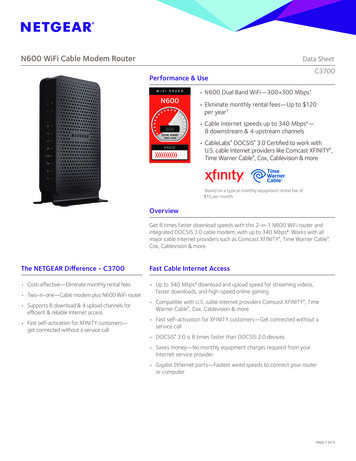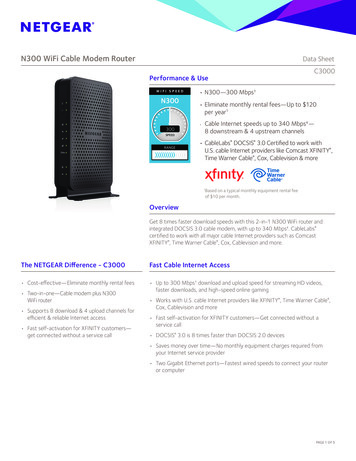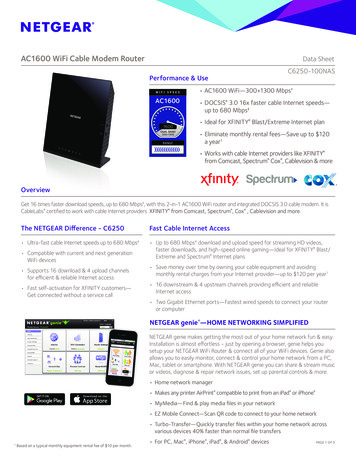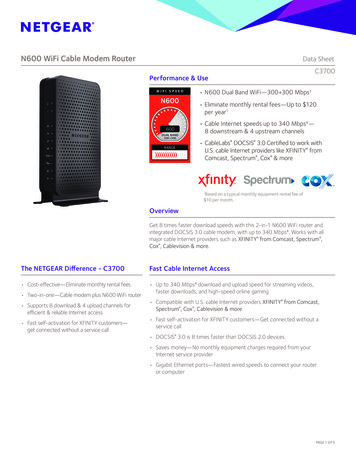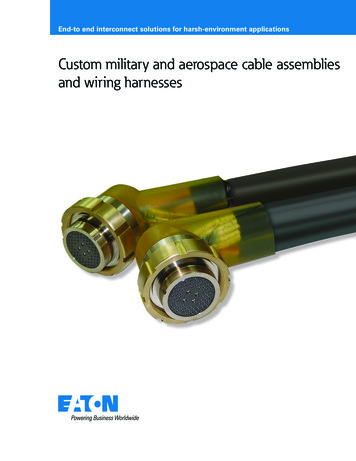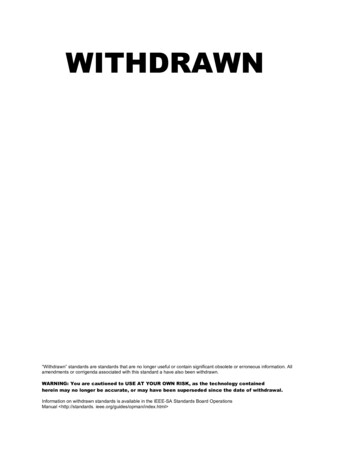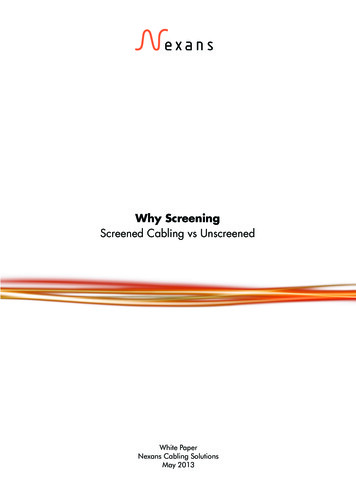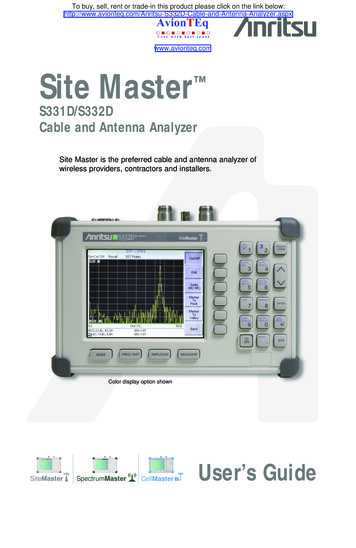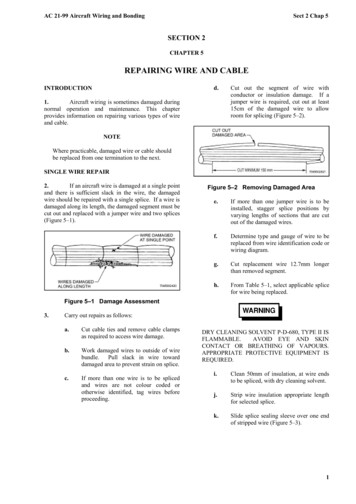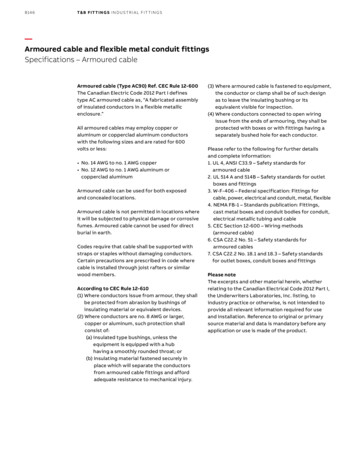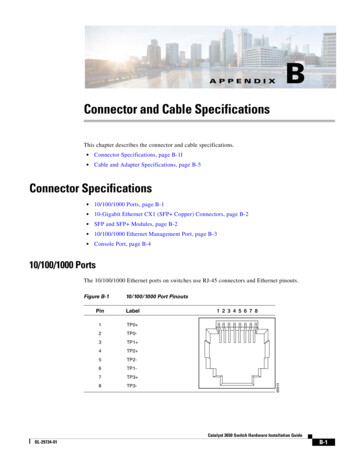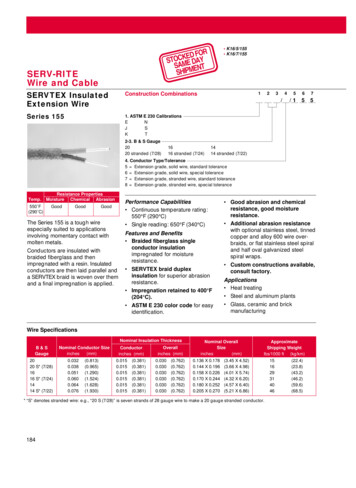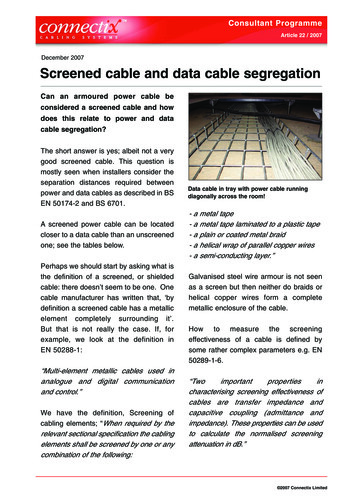
Transcription
Consultant ProgrammeArticle 22 / 2007December 2007Screened cable and data cable segregationCan an armoured power cable beconsidered a screened cable and howdoes this relate to power and datacable segregation?The short answer is yes; albeit not a verygood screened cable. This question ismostly seen when installers consider theseparation distances required betweenpower and data cables as described in BSEN 50174-2 and BS 6701.A screened power cable can be locatedcloser to a data cable than an unscreenedone; see the tables below.Perhaps we should start by asking what isthe definition of a screened, or shieldedcable: there doesn’t seem to be one. Onecable manufacturer has written that, ‘bydefinition a screened cable has a metallicelement completely surrounding it’.But that is not really the case. If, forexample, we look at the definition inEN 50288-1:“Multi-element metallic cables used inanalogue and digital communicationand control.”We have the definition, Screening ofcabling elements; “When required by therelevant sectional specification the cablingelements shall be screened by one or anycombination of the following:Data cable in tray with power cable runningdiagonally across the room!- a metal tape- a metal tape laminated to a plastic tape- a plain or coated metal braid- a helical wrap of parallel copper wires- a semi-conducting layer.”Galvanised steel wire armour is not seenas a screen but then neither do braids orhelical copper wires form a completemetallic enclosure of the cable.How to measure the screeningeffectiveness of a cable is defined bysome rather complex parameters e.g. ing screening effectiveness ofcables are transfer impedance andcapacitive coupling (admittance andimpedance). These properties can be usedto calculate the normalised screeningattenuation in dB.” 2007 Connectix Limited
Consultant ProgrammeArticle 22 / 2007So screening performance can be definedand measured, but what is the limitingfactor, below which a cable couldn’t bedescribed as screened is not defined.Cable armour is considered as part of theprotective earth circuit. In BS 7671, IEEWiring Regulations 16th edition, we have:543-02-07 “Wheretheprotectiveconductor is formed by conduit, trunking,ducting or the metal sheath and/or armourof a cable, the earthing terminal of eachaccessory shall be connected by aseparate protective conductor to anearthing terminal incorporated in theassociated box or other enclosure.”Riser access with purple data cables enteringfloor void. The power cables are flexible pmentandrefertoTelecommunications The power cables are of an earthedarmoured constructiontelecommunicationscabling – Specification for installation,So the two relevant standards in the UKoperation and maintenance, when itare B6701:2004, which is safety standard,comes to segregation between power andandtelecommunications circuits.From thistechnology - Cabling installation - Part 2:Standard we have the requirement toInstallation planning and practices insidemaintain a distance of not less than 50buildings. BS EN 50174-2 is moremmconcerned about the electromagneticbetweenpowercablesandcommunications cables, nterference)between power and data cables, rather There is a non metallic divider betweenthemthan safety, but does state that safetyissues take precedence over EMC issues. The power cables are themselves in anearthed metallic conduit The power cables are mineral insulatedTable 1 on the next page shows the Cableseparation rules from EN 50174-2:2000. 2007 Connectix Limited
Consultant ProgrammeArticle 22 / 2007Type of installationSeparation distanceWithout a divideror with a nonmetallic dividerAluminium dividerSteel mm0-mm0-mm0-mmUnscreened power cableand unscreened IT cableUnscreened power cableand screened IT cableScreened power cableand unscreened IT cableScreened power cableand screened IT cableNote that EN 50174 permits no separation for the final 15 metres of the horizontal cable run.Table 1: Cable separation rules from EN 50174-2:2000From Table 1 we can see that the worst I.T. cables are expected to be at leastcase, unscreened power cable next to130 mm from any kind of fluorescentunscreenedlamps.I.T.cable,is200-mm.The standard makes no distinctionbetween Category 5 or 6 etc., or what kind For backbone cabling the separationof screening is used. It is either adistances must be maintained end-to-screened or an unscreened I.T. cable.end. For the horizontal cabling there isThe table is mostly self-explanatory butthe practical problem of maintainingsome extra clarification is required.separations of up to 200-mm in theshared trunking that is encountered The metallic dividers are presumed to beearthed.around the walls of every office. Toovercome this problem the standardadopts a more pragmatic approach. The I.T. cables are balanced andworking with a balanced transmissioncircuit. If the cable is screened and less than 35metres in length then no separation isrequired. The power cables are standard 50 to 60Hz operation with no unusual transients If the cable is longer than 35 metres thenor high frequency or high voltagethe separation shall be maintainedcomponents.except for the last 15 metres. 2007 Connectix Limited
Consultant ProgrammeArticle 22 / 2007The above two statements do not make itTIA/EIA-569 and ANSI/NECA/BICSI 568-clear what happens to unscreened cable2001 also give separation distancesshorter than 35 metres. The bestbetween power and data cables. This isinterpretation of this clause (section 6.5.2summarised in Table 2 below.of EN 50174-2) is that for the last 15metres of the horizontal cable run noBS 6701 says that for power cableseparation is required between the datavoltages not exceeding 600 volts a.c.and power cables (apart from anythere must be a separation of at least 50-otherstandard).mm or else a non-conducting divider mustThus traditional office trunking can still bebe placed between them (7.7.4.1). Forused. If we presume that we need aroundvoltages above 600 volts a.c. thethree metres of cable to drop down therequirement is 150-mm. Table 3 overlayswall into the horizontal trunking systemEN50174 and BS 6701 to show all thethen a twelve-metre run is achievable.requirements tabulated together.over-ridingsafetyThis actually equates to 24 metres of wallif the cable run extends to twelve metresTable 3 shows the worst case conditionsin each direction away from the originalof EN 50174 and BS 6701 overlaid oncable drop.each other.ConditionMinimum separation distance 2kVA2-5 kVA 5kVAUnshielded power lines or electrical equipmentin proximity to open or nonmetal pathways.127-mm305-mm610-mmUnshielded power lines or electrical equipmentin proximity to a grounded metal conduitpathway.64-mm152-mm305-mmPower lines enclosed in a grounded metalconduit (or equivalent shielding) in proximity toa grounded metal conduit pathway.-76 mm152-mmElectrical motors and transformers--1220-mmTable 2: ANSI/NECA/BICSI 568-2001 separation distances between power and data cables 2007 Connectix Limited
Consultant ProgrammeArticle 22 / 2007Type of installationUnscreened power cableand unscreened IT cableUnscreened power cableand screened IT cableScreened power cable andunscreened IT cableScreened power cable andscreened IT cableSeparation distanceWithout adividerWith a nonmetalic dividerAluminiumdividerSteel 50-mm30-mm50-mm50-mm50-mm0-mm50-mm50-mmNote that EN 50174 permits no separation for the final 15 metres of the horizontal cable run but BS6701 alwaysrequires the separation, regardless of lenght except in the two highlighted cases seen in the table above.Table 3: Worst case conditions of EN 50174 and BS 6701 overlaid on each otherAnd finally from TIA 942 we haveTable 4: TIA 942 cable segregationIf the power cables are unshielded, then the separation distances provided in Table 4shall be doubled. However, these distances can apply to unshielded power cables if eitherthe power cables or data cables are installed in bonded and grounded metal tray. Theside or the bottom of the metal tray shall separate the power cables from the twisted-paircables, this separation surface should be solid metal.Quantity ofcircuitsElectrical Circuit TypeSeparationDistance (mm)SeparationDistance (in)Refer to 569Bannex CRefer to 569Bannex C1 - 1520A 110/240V1-phaseunshielded16 - 3020A 110/240V 1-phase shielded50 mm2 in31 - 6020A 110/240V 1-phase shielded100 mm4 in61 - 9020A 110/240V 1-phase shielded150 mm6 in91 20A 110/240V 1-phase shielded300 mm12 in1 100A 415V 3-phase shieldedfeeder300 mm12 inshielded orunshieldedTable 4: TIA 942 cable segregation 2007 Connectix Limited
Consultant ProgrammeArticle 22 / 2007ConclusionConnectix recommends that: Power and data cables are installed witha 200 mm separation wherever possible A 600 mm separation should bemaintained between data and threephase power cables Where 200 mm separation isn’t possiblethen the reduced distances of Table 3Final phase of installation. IEC 309 16A and 32Asockets positioned on steel trunking with preterminated data cables in tray work.may be used A 50 mm separation must be included asdefined in BS 6701 A suitably earthed armoured powercable may be considered as ‘screened’for the purposes of cable segregation Failure to observe the above rules maylead to non compliance with TheElectricity at Work Regulations 1989 andtheEMCRegulations2006(SI2006/3418) July 2007 Failure to observe the above rules maylead Connectix to withdraw any terms ofWarranty associated with their cablingproductsUK Head Office:Connectix Limited33 Broomhills Industrial EstateBraintree, Essex CM7 2RW 2007 Connectix Limited
2001 also give separation distances between power and data cables. This is summarised in Table 2 below. BS 6701 says that for power cable voltages not exceeding 600 volts a.c. there must be a separation of at least 50-mm or else a non-conducting divider must be placed between them (7.7.4.1). For voltages above 600 volts a.c. the
